1. Time-Height Sections
To my knowledge, we are the only group providing access to model time-height sections. I've always found this surprising because they are a wonderful tool for forecasting.
Most of the time-height sections on our site are produced with BUFR sounding data from either the NAM or GFS model. BUFR sounding data pulled directly from each model at very high vertical resolution, enabling highly detailed time-height sections.
Time-height sections show the evolution of the atmosphere with time over point. We plot ours so that time increases to the left. This sounds strange, but it results in the winds appearing to curve cyclonically with a trough passage, which is easier to visualize if time increases to the right and they appear to curve anticyclonically. The time heights we produce include wind barbs, relative humidity (color filled), and equivalent potential temperature (a.k.a. theta-e). Equivalent potential temperature is a thermodynamic quantity based on both temperature and moisture that is very useful for identifying fronts (strong horizontal gradient or contrast), stable layers (strong vertical gradient or contrast), and areas of instability or potential instability (little change or a decrease in equivalent potential temperature with height). We also plot the model freezing level and areas of potential instability on these plots.
The time-height below is from today's NAM and for Salt Lake City. Note the arrival of the forecast front around 12Z on Monday and the wind shift and low-level moisture associated with it. I find these plots to be extremely useful for examining flow direction changes with height, humidity (and inferred clouds) and their distribution, and the timing of fronts and related changes in stability. In turn, I use this information to anticipate how the mountains will affect the weather.
2. Soundings
We also produce soundings with the BUFR data on a Skew T/log P diagram. The Skew T is a special diagram with tremendous applications for forecasting. I can't explain it in 1,000,000 words or less (I've tried), but if you sign up for an account, you can learn about it for free at the COMET Meted site. The bottom line is that these soundings provide information about the distribution of wind, temperature, humidity, and atmospheric stability that can be used for everything from the forecasting of thunderstorms to the evolution of the inversion.

3. Meteograms
These are time series of forecast weather conditions at specific points. They are a mixture of direct model output and algorithm-derived products developed by my group. Below is the NAM meteogram for Alta from today's run.
Keep in mind that in most instances, no attempt has been made to adjust these forecasts for local effects, which can have a strong influence on the weather. They are meant to be used as guidance for a forecast, rather than as a forecast.
4. Little Cottonwood Canyons Guidance
Same as the meteograms, but in tabular format. Click here to access. Again, this is guidance, not a forecast.
5. Great Salt Lake-Effect Meteograms
Time series of several variables commonly used to forecast lake effect precipitation. Includes direct model forecasts and some algorithm derived variables (e.g., Great Salt Lake Effect probability). Again, this is guidance.
6. Great Salt Lake-Effect Guidance
Same as meteogram, but in tabular format. Click here to access.
7. Summary
That was a lot of spaghetti to throw at the wall. Try putting together a forecast for the Sunday Night/Monday storm and see what sticks!




Great news about the NCAR 3-km Ensemble that is coming! I have yet to find anything that can forecast local thermal winds in Utah. I really wish the NWS or the U of U would run a 2km WRF-GFS.
ReplyDeleteThanks for all your hard work and great communication with the untrained masses!!!
ReplyDeleteJim, you da man...seriously
ReplyDeletei've been using this for a while: http://coolwx.com/cgi-bin/getbufr.cgi?region=VT&stn=KVSF&model=nam&time=current&field=relh
ReplyDeletenice talk the other night
anybody know where the buff stuff is
ReplyDelete